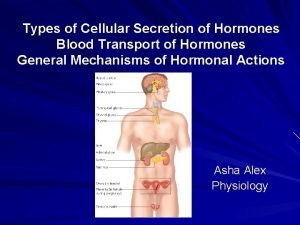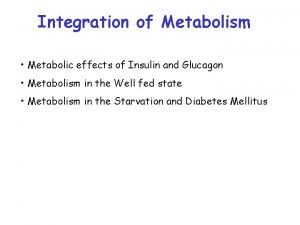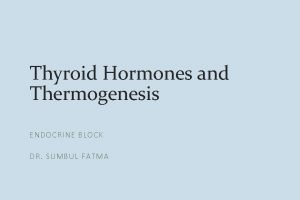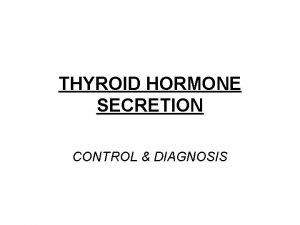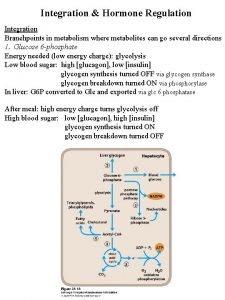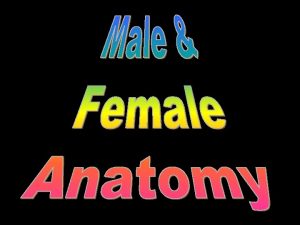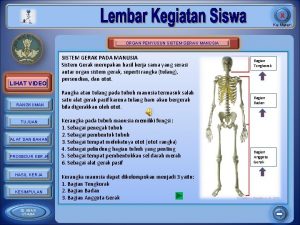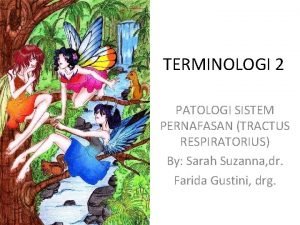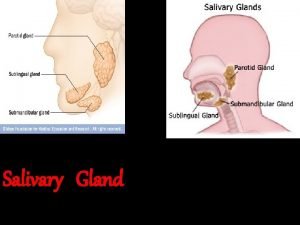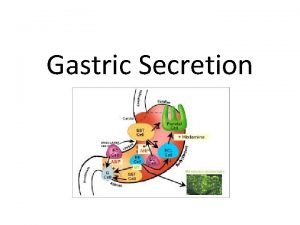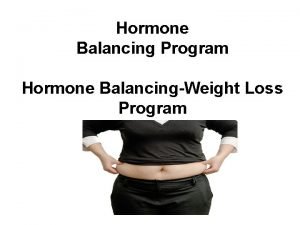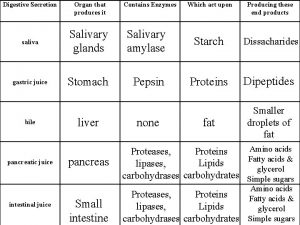Gland any organ that produces a secretion Hormone












- Slides: 12


• Gland- any organ that produces a secretion • Hormone- chemical messenger

Endocrine Glands • Secrete hormones directly into bloodstream • Ductless Exocrine Glands- secrete substances through a duct (sweat, salivary, lacrimal and pancreas) Function of the Endocrine System- to secrete hormones- chemical messengers that coordinate and direct target cells and organs Two Types of Control of Endocrine System 1) Hormonal Control- involves negative feedback • Drop in hormone level triggers a chain reaction to increase secretion, for example 1. Blood level of hormone falls 2. Brain gets message and sends out hormone to stimulate gland 3. Gland stimulates more hormone 4. When blood levels of hormone increase, the brain hormones stop • Read “Hormonal Control” p. 137 (I. M. )

2) Nervous Control • In some cases, sympathetic nervous system causes direct release of hormone from gland (for example, when stress causes the adrenal gland to secrete adrenalin) Pituitary Gland p. 200 • Tiny structure the size of a grape • Located at the base of the brain • Connected to the hypothalamus • Divided into anterior and posterior lobes • The “Master Gland” Anterior Pituitary Lobe (chart p. 199) • Growth hormone- GH responsible for growth and development • Prolactin- develops breast tissue, stimulates production of milk after childbirth • Thyroid-stimulating hormone- TSH- stimulates the thyroid gland to produce thyroxine • Adrenocorticotropic Hormone- ACTH- stimulates adrenal gland • Follicle-stimulating hormone-FSH- stimulates growth of graafian follicle and production of estrogen in females, sperm in male • Luteinizing hormone- LH- stimulates ovulation and formation of corpus luteum, which produces progesterone in females

• Anterior Pituitary Lobe (chart p. 199) • Growth hormone- GH responsible for growth and development • Prolactin- develops breast tissue, stimulates production of milk after childbirth • Thyroid-stimulating hormone- TSH- stimulates the thyroid gland to produce thyroxine • Adrenocorticotropic Hormone- ACTH- stimulates adrenal gland • Follicle-stimulating hormone-FSH- stimulates growth of graafian follicle and production of estrogen in females, sperm in male • Luteinizing hormone- LH- stimulates ovulation and formation of corpus luteum, which produces progesterone in females

Posterior Pituitary Lobe • Vasopressin- converts to ADH (antidiuretic hormone) in the bloodstream, acts on kidney to concentrate urine and preserve H 2 O in the body • Oxytocin- released during childbirth causing contractions of the uterus Thyroid Gland • Butterfly-shaped mass of tissue • On either side of larynx, over trachea • Main hormone- thyroxine- is controlled by the secretion of TSH from the pituitary gland • Thyroxine controls the rate of metabolism Parathyroid Glands • Four glands, each the size of a grain of rice • Attached to posterior thyroid • Produce parathormone which helps control blood calcium level, prevents hypocalcemia Thymus (p. 204) • Endocrine gland lymphatic organ • Located behind the sternum, above and in front of the heart • Begins to disappear at puberty • Produces T-lymphocites

Adrenal Glands • Located on top of each kidney • Adrenal cortex secretes hormones known as corticoids- they are anti-inflammatory • They are: mineralcorticoids, glucocorticoids, androgens (male sex hormones) • Adrenal medulla secretes epinephrine (adrenalin) and norepinephrine • Adrenalin is a powerful cardiac stimulant- “fight or flight” hormones that prepare the body for an emergency situation Gonads • Ovary in female secretes two hormones 1. Estrogen- responsible for development of female reproductive organs and secondary sex characteristics 2. Progesterone- plays a part in the menstrual cycle and pregnancy • Testes in male Testosterone- responsible for male reproductive organs and secondary sex characteristics Pancreas • Located behind the stomach • Endocrine and exocrine functions • Involved in production of insulin by islets of langerhans (endocrine function) • Insulin promotes utilization of glucose by the cells Do you remember the pancreas’ exocrine function? Hint: Digestive system

Other Hormones • Prostaglandins- tissue hormones, can cause constriction of blood vessels, muscle contractions. Can be used to induce labor. (p. 208)

Gigantism • Hyper function of pituitary- too much growth hormone (GH) in the preadolescent • Overgrowth of long bones leads to excessive tallness Acromegaly • Hyper function of pituitary- too much growth hormone in adulthood • Overdevelopment of bones in face, hands and feet • Attacks cartilage- so the chin, protrudes, lips, nose and extremities enlarge • Rx- drugs to inhibit growth hormone, radiation Dwarfism • Hypofuction of pituitary in childhood • Small size, but body proportions and intellect are normal • Sexual immaturity • Rx- early diagnosis, injection of growth hormone

Hyperthyroidism • Overactive thyroid gland • Too much thyroxine secreted leading to enlargement of gland • People with this disease consume large quantities of food but lose body fat and weight • Most pronounced symptoms are enlargement of gland (goiter) and bulging of eyeballs (exophthalmos), higher metabolism, nervousness, diarrhea, sleeplessness • Rx- total or partial removal of thyroid gland, drugs to reduce thyroxine, radiation Hypothyroidism • Not enough thyroxine secreted • May be due to lack of iodine (simple goiter) • Major cause of other types is inflammation of thyroid which destroys the ability of the gland to make thyroxine • Symptoms- dry and itchy skin, dry and brittle hair, constipation, muscle cramps, weight gain, lower metabolism, depression, lower concentration Tetany • In hypoparathyroidism, decreased calcium levels affect function of nerves • Convulsive twitching develops, person dies of spasms in the respiratory muscles • Rx- Vitamin D, calcium and parathormone

Diabetes Mellitus • Caused by lower secretion of insulin • Pancreas releases insulin as blood glucose levels rise (after eating), insulin makes it possible for blood glucose to move out of the bloodstream into the cells. • Symptoms of DM- polyuria, polyphagia, polydipsia, weight loss, blurred vision, delayed healing, and possible diabetic coma • Excess glucose in blood (hyperglycemia) and glucose secreted in urine (glycosuria) • Since glucose is not available for cellular oxidation, body starts to burn up protein and fat (this is what causes the weight loss) • Rx: oral medication, insulin by injection • If too much insulin, is given, blood sugar may go too low and cause hypoglycema. Symptoms are dizziness, fatigue, anxiety, irritability, HA, hunger and possible insulin shock. Rx: sugar • Tests for diabetes- blood sample measured in glucometer- done by patient at homenormal blood sugar 80 -100 mg.

Type 1 • Autoimmune disease • Pancreas does not make insulin • Usually occurs in children and young adults • May occur in older adults (LADA Late Onset Autoimmune Diabetes in Adults) • Most people will have to take insulin for the rest of their lives Type 2 • Hereditary causes • Pancreas makes some insulin but not enough • Body does not use insulin well • May occur in children who are overweight (MODY Mature Onset Diabetes in Youth) • May be able to control with or without pills but may also need insulin • More common than type 1 Gestational Diabetes: Gestational diabetes mellitus (GDM) is a type of diabetes that develops only during pregnancy. It will usually develop between the 24 th and 28 th week of pregnancy and will probably go away after the baby is born.
 Types of hormone secretion
Types of hormone secretion Hormone secretion
Hormone secretion Thyroid hormone secretion
Thyroid hormone secretion Erythropin
Erythropin Adrenal gland hormone
Adrenal gland hormone Endocrine gland hormone
Endocrine gland hormone Integration metabolism
Integration metabolism Pituitary gland and pineal gland spiritual
Pituitary gland and pineal gland spiritual Pineal gland pituitary gland
Pineal gland pituitary gland What organ produces testosterone
What organ produces testosterone Identify the structure
Identify the structure Fungsi organ penyusun sistem gerak manusia
Fungsi organ penyusun sistem gerak manusia Organ organ pernafasan
Organ organ pernafasan
